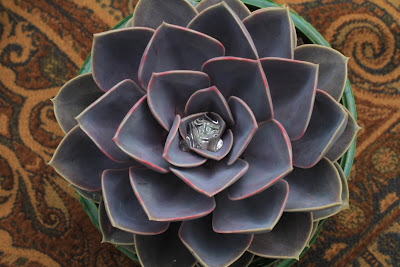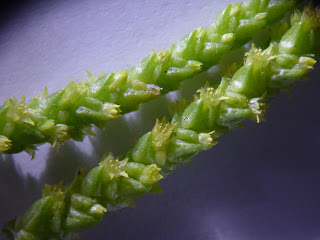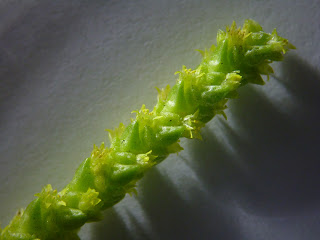
These mid-century McCoy “shingle” flower pots and attached saucers are typically marked “McCoy, USA” on the bottom with the mark shown below. McCoy produced this style flower pot in a variety of sizes and bright colors like aqua, Kelly green, yellow, pink, plum, brown, white in the 1940s and 1950s. Were they used as floral gifts or did people buy them? The ones we’ve picked up over the years are very well-used so I figured why not continue to use them instead of stacking them on a shelf. Here three pots are shown on the Travelmarx deck with Crassulaceae: (left) Echeveria 'Perle Von Nürnberg', (middle) Echeveria ‘Nodulosa’, and (right) Crassula muscosa var. pseudolycopodiodes.
“Muscosa” is Latin for mossy, referring to this plant’s moss-like looks. SMGrowers.com says that “it has also been called Crassula lycopodioides which is in reference to the plant being like Lycopodium, a genus of clubmoss.” Just a step from this to pseudo-lycopodiodes? The genus Echeveria was named to honor Mexican botanical artist Atanasio Echeverría y Godoy in 1828 by the French botanist Augustin Pyramus de Candolle (DeCandolle) who was very impressed with Echeverría's drawings.

“Muscosa” is Latin for mossy, referring to this plant’s moss-like looks. SMGrowers.com says that “it has also been called Crassula lycopodioides which is in reference to the plant being like Lycopodium, a genus of clubmoss.” Just a step from this to pseudo-lycopodiodes? The genus Echeveria was named to honor Mexican botanical artist Atanasio Echeverría y Godoy in 1828 by the French botanist Augustin Pyramus de Candolle (DeCandolle) who was very impressed with Echeverría's drawings.


One Year Later, 10/1/2012


10/9/2012
A Steller’s Jay (Cyanocitta stelleri) Tearing Apart an Echeveria

A Steller’s Jay Inspecting the Crassula muscosa var. pseudolycopodiodes

11/13/2012 We brought the Crassula muscosa var. pseudolycopodiodes inside to avoid some cold weather while we were away for a few days. We put it in the kitchen. When we got home the house had a strange but pleasant smell – part spathiphyllum, part fenugreek. We tracked it down to C. muscosa in bloom. Here are some close ups of the flowers. Five stamens.
Close Up of Crassula muscosa var. pseudolycopodiodes Flowers


No comments:
Post a Comment
All comments are moderated. If your comment doesn't appear right away, it was likely accepted. Check back in a day if you asked a question.